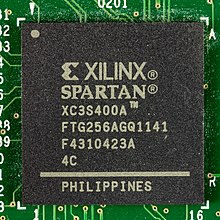
Back مصفوفة البوابات المنطقية القابلة للبرمجة Arabic Field Programmable Gate Array BAR FPGA Bulgarian ফিল্ড-প্রোগ্রামেবল গেইট অ্যারে Bengali/Bangla Matriu de portes programable in situ Catalan Programovatelné hradlové pole Czech Field-Programmable Gate Array Danish Field Programmable Gate Array German FPGA Greek Agordebla Matrico de Logikaj Elementoj Esperanto


A field-programmable gate array (FPGA) is a type of configurable integrated circuit that can be repeatedly programmed post manufacturing. FPGAs are a subset of logic devices referred to as programmable logic devices ("PLDs"). They consist of an array of programmable logic blocks with a connecting grid, that can be configured "in the field" to interconnect with other logic blocks to perform various digital functions. FPGAs are often used in limited (low) quantity production of custom-made products, and in research and development, where the higher cost of individual FPGAs is not as important, and where creating and manufacturing a custom circuit wouldn't be feasible. Other applications for FPGAs include the telecommunications, automotive, aerospace, and industrial sectors, which benefit from their flexibility, high signal processing speed, and parallel processing abilities.
A FPGA configuration is generally written using a hardware description language ("HDL") e.g. VHDL, similar to the ones used for application-specific integrated circuits ("ASIC“). Circuit diagrams were formerly used to write the configuration.
The logic blocks of an FPGA can be configured to perform complex combinational functions, or act as simple logic gates like AND and XOR. In most FPGAs, logic blocks also include memory elements, which may be simple flip-flops or more sophisticated blocks of memory.[1] Many FPGAs can be reprogrammed to implement different logic functions, allowing flexible reconfigurable computing as performed in computer software.
FPGAs also have a role in embedded system development due to their capability to start system software development simultaneously with hardware, enable system performance simulations at a very early phase of the development, and allow various system trials and design iterations before finalizing the system architecture.[2]
FPGAs are also commonly used during the development of ASICs to speed up the simulation process.
- ^ Cite error: The named reference
FPGAwas invoked but never defined (see the help page). - ^ Simpson, P. A. (2015). FPGA Design, Best Practices for Team Based Reuse, 2nd edition. Switzerland: Springer International Publishing AG. p. 16. ISBN 978-3-319-17924-7.
© MMXXIII Rich X Search. We shall prevail. All rights reserved. Rich X Search